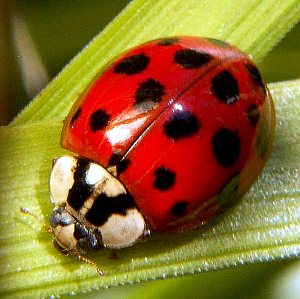
photo by Bruce Martin, from Wikipedia Commons.
The Asian Ladybird Beetle sometimes has other names, including Asian multicolored lady beetle.
We all know the scene- a warm fall day and you are standing at a window daydreaming when you realize there is an insect on the screen. You look around and – then you see them, dozens of live and dead small, crunchy beetles from yellow to bright red, usually with scattered black spots. They are clogging the windowsill, drying in your light fixture, flying and dying in droves. ARRG! What is happening?
These are most likely Asian Ladybird beetles (Harmonia axyridis), a species that has spread throughout North America after arriving from Eastern Asia. These lovely “ladybugs” have a large extended family- about 5,000 species worldwide, 450 in North America. The family, Coccinellidae, is often called the “ladybird beetle” or “lady bug”. Its name (Latin coccineus) means “scarlet”, and the English “lady” of lady bug and lady bird, is Mary, the mother of Jesus often depicted in red in medieval paintings. This particular species was introduced in to the US several times in the early twentieth century in an attempt to control other insects, but did not take off until the late 1980s. Now it occurs in large numbers across a swath of US states.
In the fall, Asian ladybird beetles can gather in large groups, moving from fields to the cracks in warm houses. What they are trying to do is find a warm crack to hibernate in, and they use pheremones to call each other into large groups. They love the warmth of dark screens, and crave the sunny side of houses with hiding places. Once hibernating, a warm mid winter day in the sun might wake a few, and you might be surprised by a January beetle flying around.
But the fall is when we see them most. They crawl over walls, and get into windows, their caselike outer wings lift and their thin membranous underwings unfurl and lift them buzzing, around the room. Before you reach for some type of insect spray, however, think twice. The ladybird beetle’s voracious larvae clean fields of aphids and sweep across those horticultural beauties you so lovingly tend around your house and lawn- eating pests and protecting plants. They save the lives of pecan trees in the south, and chow on pests decimating soybeans in the midwest. They won’t bite you,(well actually they will, but only if you grab them and you have to admit, if something a thousand times larger than you grabbed you, you would bite too). They don’t carry disease, and won’t eat your food, plants, rugs or books. Although they are non-native, and compete with native ladybird beetles, they are at least somewhat beneficial. *So enjoy the travels of the gentle ladybug, a flying red beetle with spots, who represents the virgin Mary in European lore, and saves your roses and those Thanksgiving pecans, by devouring aphids.
*They also let out a smell when frightened. If you find them too much to bear, simply vacuuming is a good option.
for more:
R. L. Koch (2003). “The multicolored Asian lady beetle, Harmonia axyridis: A review of its biology, uses in biological control, and non-target impacts” (PDF). Journal of Insect Science 3: 32. PMC 524671.PMID 15841248
“Ohio State University Extension Fact Sheet”. Ohioline.osu.edu. Retrieved 2010-07-03.
